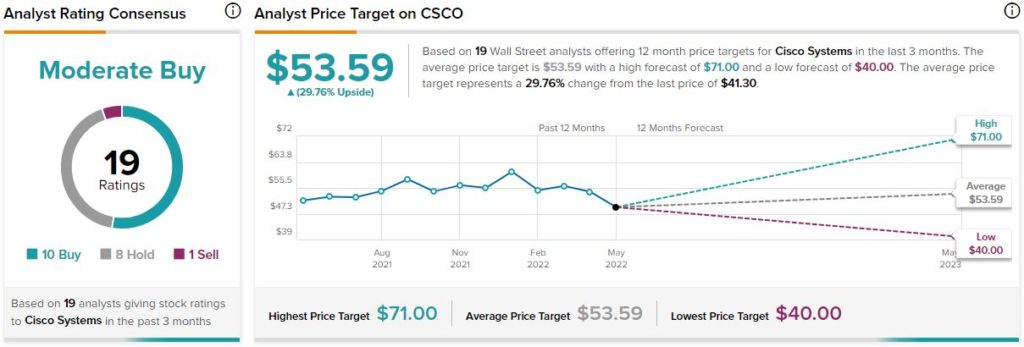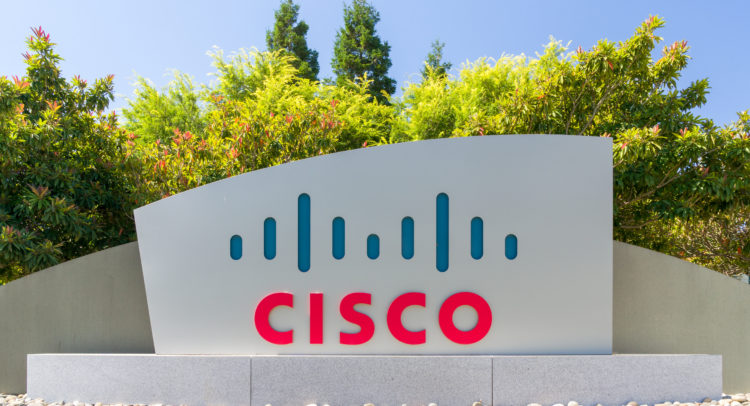When networking giant Cisco (CSCO) lost 10.7% in premarket trading, that was bad enough news for everybody. The news was so bad that it hit several of Cisco’s rivals, including Broadcom (AVGO) and Juniper Networks (JNPR). Broadcom is down 3.6%, and Juniper is down 4.2%.
Currently, CSCO’s losses for the day amount to 14.6%. Cisco’s explanation for its losses, meanwhile, makes a distressing amount of sense.
The end result of these losses, however, makes me wonder if the entire field is starting to contract, and that’s enough to turn me bearish on Cisco for a while. It’s hard to recommend buying in, and the potential troubles facing Cisco are likely to boil down into the industry as a whole.
While the last 12 months for Cisco stock have been volatile, the ultimate result of that volatility is bad news. The company is now trading for around $10 per share less than it was this time last year. For a company that was over $60 a share at the beginning of the year, that’s definitely not good news.
The latest news will provide little help. The company cut its forecast for the full fiscal year, citing familiar factors: the ongoing Russia-Ukraine war and the also-ongoing COVID-19 lockdowns in China.
The company also revealed earnings that had been hit hard; revenue for the fiscal third quarter came in at $12.8 billion, which was about 4% below what analysts had forecast.
FactSet analysts noted that this was only the second time in the last five years that Cisco turned in a miss. Worse yet, the previously-noted forecast was dropped to $12.7 billion, which in turn was about 8% under what Street expectations called for.
Wall Street’s Take
Turning to Wall Street, Cisco has a Moderate Buy consensus rating. That’s based on 10 Buys, eight Holds, and one Sell assigned in the past three months. The average Cisco price target of $53.59 implies 29.8% upside potential.

Analyst price targets range from a low of $40 per share to a high of $71 per share.
Investor Sentiment is Turning Against Cisco
Cisco leads off with further bad news in the form of its TipRanks Smart Score, which comes in at a meager 2 out of 10. That puts it at “underperform” and only one level above the lowest, making it unlikely that this stock will outperform the broader market.
The rest of the investor sentiment indicators, meanwhile, are also turning against Cisco. Hedge fund involvement, as measured by the TipRanks 13-F Tracker, has been on a steady decline since June 2021.
In fact, the latest quarter saw the biggest drop in months. Hedge funds went from owning a little under 84 million shares of CSCO to owning just under 62.3 million shares in the space of three months.

Meanwhile, insider trading—especially of late—is fairly heavily sell-weighted. In the last three months, sell transactions led buy transactions nine to four. Going back over the last 12 months, meanwhile, sees sell transactions also lead buy transactions, this time by 42 to 25.
As for retail investors who hold portfolios on TipRanks, that’s also a negative indicator that’s getting worse rather than better. TipRanks portfolios that hold Cisco stock are down 0.5% for the last seven days and down 0.2% for the last 30 days.
Finally, there’s the one bright spot in the whole matter: Cisco’s dividend history. It’s ideal by income investor standards. Its dividend has not only been paid out for more than 10 years, but it’s been steadily rising during that whole time. Maintaining a dividend during the pandemic era was tough enough, but raising it during that time was an even bigger win for Cisco.
A Tougher Field for Big Iron
Seeing the biggest problem for Cisco is about as easy as going to Cisco’s product page. Here, you’ll find a fairly complete list of Cisco’s product offerings. It’s got a nice broad slate of hardware offerings. The company boasts hardware for networking, wireless and mobility systems, security tools, Internet of Things (IoT) capability, and more.
That, however, is part of the problem. Looking at the roster of Cisco products by technology shows that, in around two-thirds of cases, Cisco is selling hardware. Even its security operations are at least partially hardware-based, with secure endpoints as part of the picture.
Its software portion is one part in nine on the technology listings. Its analytics section is certainly more software-based than anything, but there are only three listings in that entire portion.
Take these points together, and Cisco becomes distressingly hardware-heavy. Hardware is all fine and well. Certainly, software is meaningless without hardware to run it on. However, hardware is also a troubling sell. It’s the biggest part of a lot of budgets. However, once it’s bought, it tends to stay bought for several years.
This means that there’s not a lot of recurring revenue going back into Cisco; rather, it has to always be closing, constantly selling new hardware to stay afloat. IBM (IBM) suffered a similar fate until it put more of its operations into applications and software.
Of more concern is the reasons Cisco’s pointing to for its own losses. The war in Ukraine is certainly driving down some demand. Both Russia and Ukraine will be a lot less concerned about buying Cisco hardware while they’re shooting at each other. Meanwhile, the lockdown in China is weighing on Cisco the other way: supply.
Right now, Cisco is running into constraints on a whopping 350 individual components. Once the locked-down regions in China open back up, that will help matters.
However, with China apparently trying to eradicate COVID-19 completely, help may not arrive soon. Any relief, meanwhile, won’t trickle down to companies quickly. Competition for space at ports will run white-hot as soon as operations restart.
Concluding Views
Cisco is running into the perfect storm of bad news for any company that’s hardware-heavy in its product line. It’s going to be tougher for Cisco to sell products for a while.
Many purchases have already been made thanks to the shift to remote work. However, with products harder to get and demand dropping, that’s bad news from both sides for Cisco.
The problems hitting Cisco are hitting plenty of other companies and industries as well. Cisco also isn’t offering a lot of products with recurring income.
Some subscription-based products, or software products, that it could use to cover the gap in hardware sales might have helped. The lack of these will leave Cisco flat-footed for a while.
Take that, along with declining investor sentiment, and the picture doesn’t look good for Cisco’s near-term future. Sure, Cisco is selling near its lowest price targets and the lowest price it’s been in a year.
Nonetheless, Cisco’s ability to produce and sell—at least for the next few months—is going to be inherently hampered. That’s exactly why I’m bearish on the company, going forward.
Discover new investment ideas with data you can trust.
Read full Disclaimer & Disclosure









